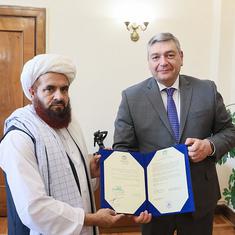Known for his unbelievable virtuosity, superb intonation, unpredictability, and above all, a unique tonal quality, Bade Ghulam Ali Khan (1901-1968), doyen of the Patiala gharana, took the world of Hindustani music by storm in the 1940s. Though inimitable, he left behind a stylistic legacy that has impacted several vocalists of successive generations.
In the series featuring conversations with maestros of Hindustani music, here are two interviews with Bade Ghulam Ali Khan included on a single track. Despite his indifferent health during the first interview, he responds in great detail to wide-ranging questions posed by noted vocalist Naina Devi. He describes his tutelage under his uncle Kale Khan and his father Ali Baksh, and enumerates the stylistic features of the Patiala gharana. Perfect intonation, respect for the structure and the grammar of the raag, proper elaboration of the composition, clarity in taans or swift melodic passages, and preventing the raag and the khayal composition from losing their original character and transforming into a thumri, are some of the characteristics that he mentions. He demonstrates his vocal and tonal range that he had developed as per the instruction he had received and the practice regimen that he had followed.
Responding to a question about styles of thumri, he states that the Purab style was the original one and was later adopted by singers in Punjab. He emphasises that the thumri form cannot be presented well by all artistes, as it requires a different sensibility that is not easy to come by. He elaborates on this by demonstrating the Purab and Punjab styles, constantly mimicking the defects that are noticeable in some thumri singers. In this context, he refers to the exaggerated vocal articulation, the excessive theatrical element and the forceful projection, that he believes hampers the presentation of some singers in both styles.
Dismissing novelty
Bade Ghulam Ali Khan is dismissive of the introduction of new raags in the Hindustani system. He believes this lacks logic and basis, and is often done only to create novelty. In this context, he refers to raags like Kirwani and Charukeshi that were adopted from the Carnatic system. Interestingly, these two raags have been made popular over the past few decades by extremely popular and well-respected performers who have regarded Bade Ghulam Ali Khan as a pathbreaker and an idol, thus proving that changes in repertoire and presentation are inevitable in spite of opposition from older musicians. Bade Ghulam Ali Khan also explains the structural requirements of raags in the Hindustani system. Contradicting popular perception that performers do not articulate their thoughts on the structure and grammar of raags, Bade Ghulam Ali Khan presents his views candidly.
Asked for his reaction to patronage for Hindustani music at the time that this interview was taken, Bade Ghulam Ali Khan states that the number of listeners has increased but not all in the audience are informed about musical subtleties. He compliments the state for its patronage, but he is not very hopeful about the outcome of institutionalised music education. In fact, he clearly states that those who train in music institutions can only be employed as music teachers in schools but cannot perform. He rates practice higher than theory, thus revealing the dichotomy and the tension that existed between practitioners and theoreticians. Clearly, his statements are a reflection of the dismissive position held by many hereditary musicians towards institutionalised music education and knowledge based on the written word.
The 52” interview ends with demonstrations of his compositions.
The second interview features Bade Ghulam Ali Khan’s thoughts on the evolution of raags. He demonstrates various folk melodies found in various parts of India and neighbouring regions that he believes later evolved into forms that are now recognised as established raags.










